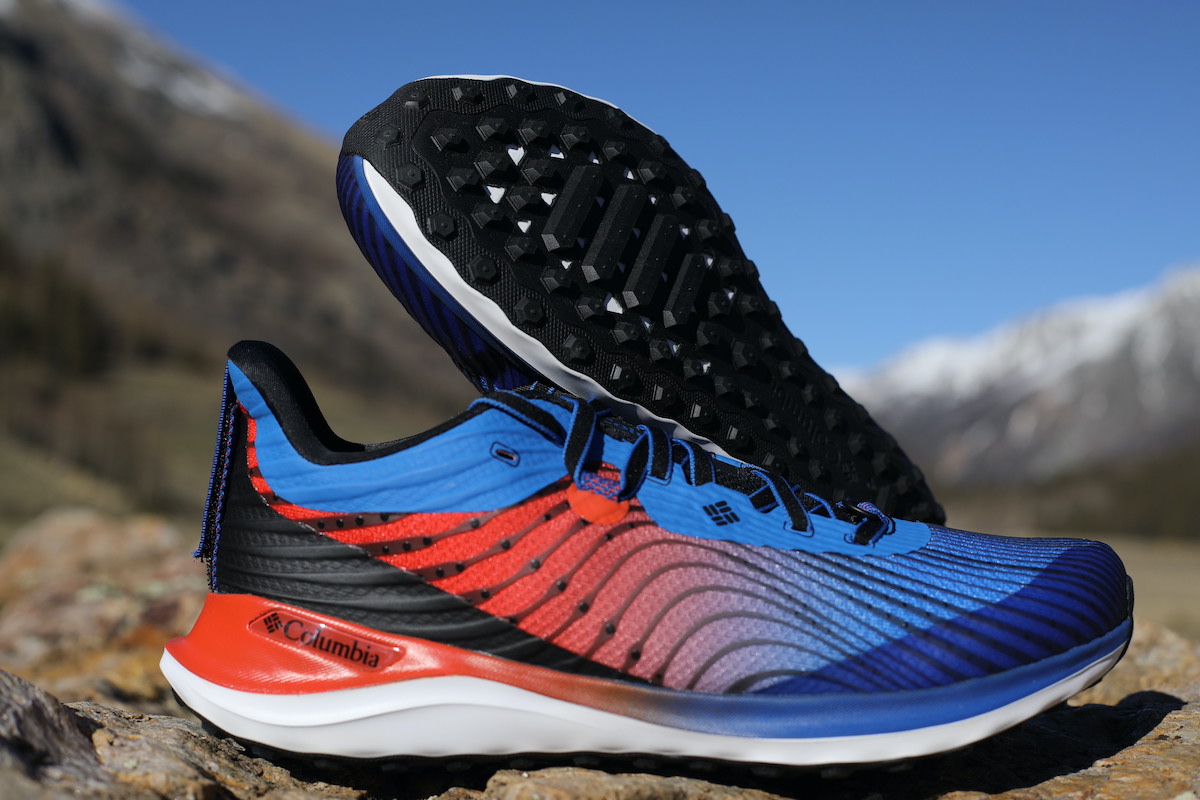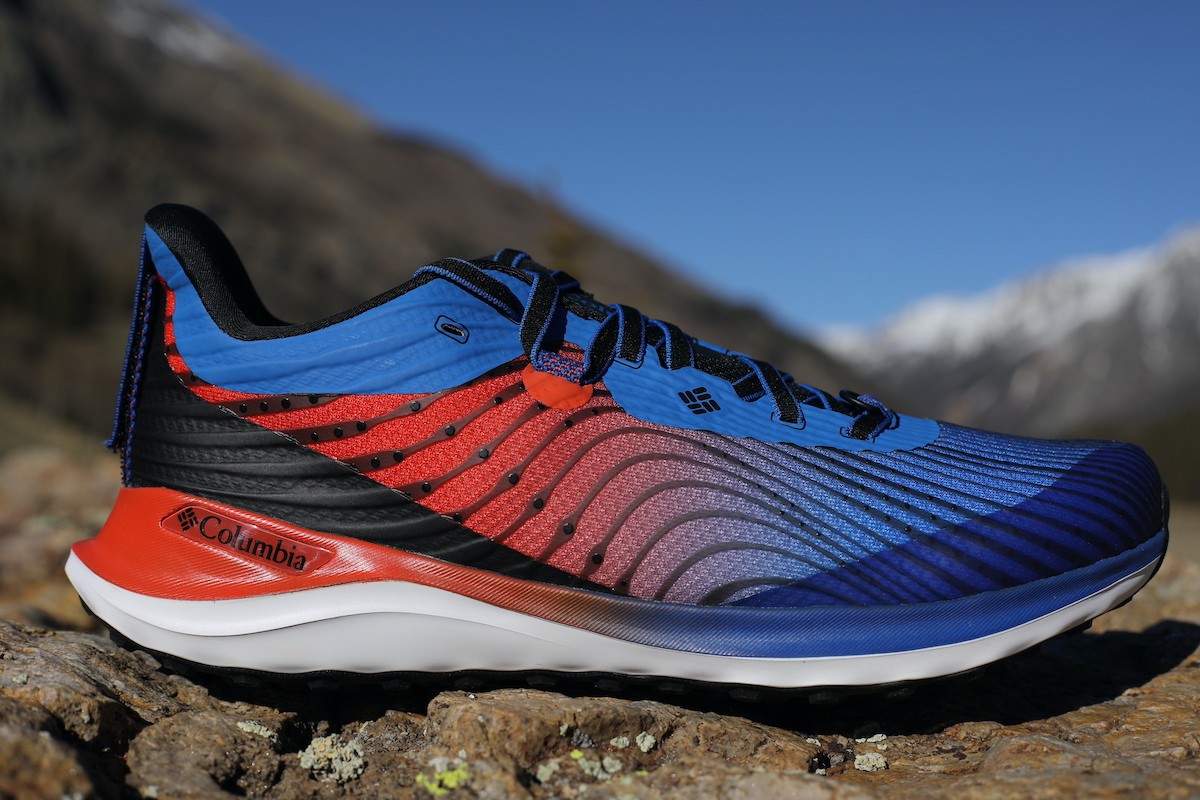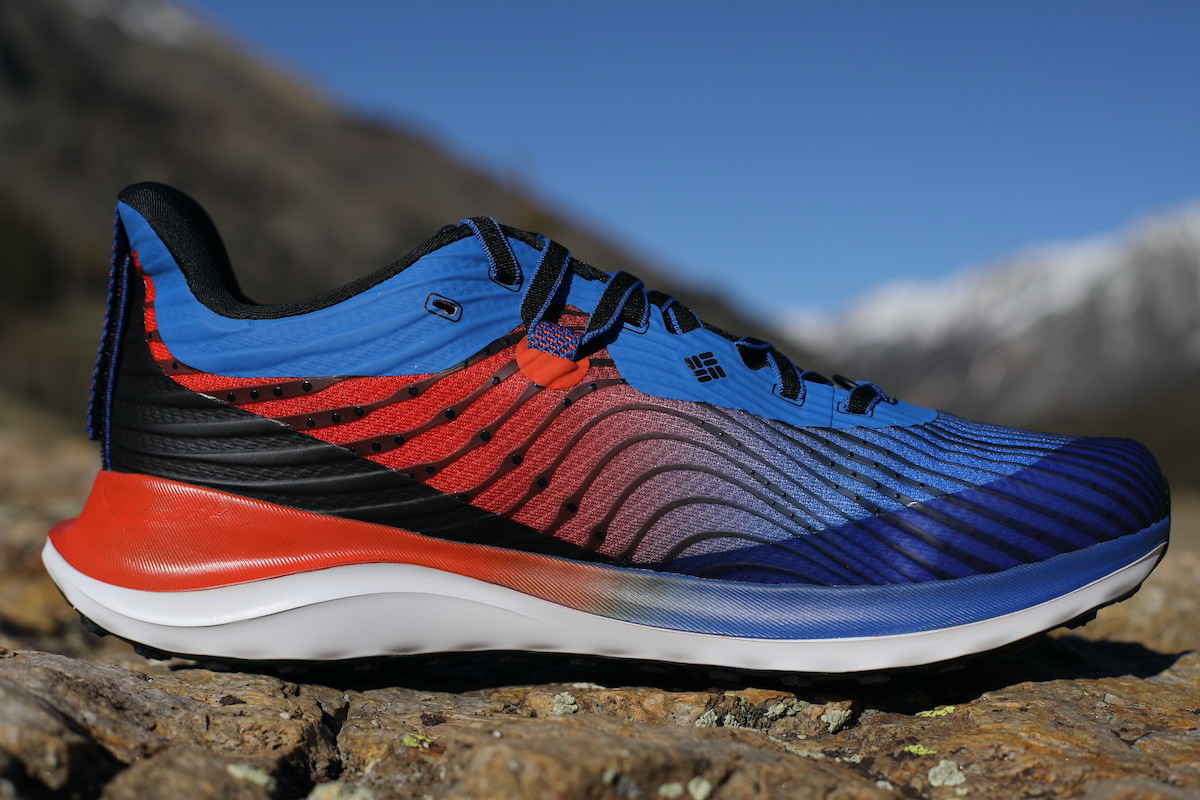Door-to-trail shoes that excel in mild and moderate terrain and in a variety of weather conditions are having their moment in the trail running shoe market, and that includes the Columbia Escape Ascent ($69 to $140). Now more than ever, brands are showcasing new technologies that take products from being an afterthought to a star of their trail lineup. Columbia has done just that with the Escape Ascent. Three new technologies —Navic Fit System, Techlite+, and Adapt Trax— work together to create a surprisingly nimble yet stable and protective running experience in wet and dry conditions, on everything from jeep roads to singletrack and slab. If mud, snow, ice, tundra, talus, or scree feature heavily in your runs, this is perhaps not the right choice. However, for many a daily run, the comfort and ease of running in this shoe make it pretty easy to throw into your gear bag.
The Columbia Escape Ascent is an 8-millimeter drop shoe and is relatively svelte at an advertised weight of 8.25 ounces (233 grams) for women’s size 7 and an actual weight of 10.4 ounces (294 grams) for men’s size 9. The price varies with the wide variety of colors available, from a steal at $69, to a fairly common $140 for the newest colors.
Shop the Women's Columbia Escape AscentShop the Men's Columbia Escape Ascent
Columbia Escape Ascent Upper
The upper of the Columbia Escape Ascent is constructed of seamless mesh which makes for a very smooth interior that feels comfortable with any running sock thickness. Though it’s not the widest fit, the upper retains some stretchiness which keeps even my over-achieving third, fourth, and fifth toes happy and able to wiggle. The mesh is quite breathable and quick to drain even on the 90-plus-degree-Fahrenheit days with the occasional stream crossing. Lightweight structure and support is added to the flexible upper via the Haptic Print Technology which lays down a striped web of sorts over the entire upper and integrates with the lacing holes and the Navic Fit System. This fit system delivers a secure midfoot lock via the placement of the lace holes through the midfoot region, in addition to offering the hole option nearest the ankle for alternate lacing strategies. The overall fit feels like a really comfortable road shoe with how the upper conforms to the foot. While it has less of a bomber protection feel, it is exactly as it should be for the type of trails the shoe is designed.
Flat laces stay tied in double knots without the need for a redo, and I found it simple to adjust the laces to my feet each run as the miles added up. The horizontal lace at the toe end has a webbing guide with an unobtrusive D-ring attached for your gaiter of choice — this eliminates the need to hook it to the lace itself which is brilliant and keeps the lace tightness and angle from being altered by the gaiter. On the heel aspect of the upper, a long velcro loop runs from the top to the midsole for the posterior attachment of a gaiter, or for attaching your gear bag without a carabiner. I love this touch, though it can be more or less useful for gaiter attachment depending on which brand I wear. The well-proportioned, perfectly padded, gusseted tongue keeps the top of the foot protected and dries quickly.
Lastly, the toes of the Columbia Escape Ascent are protected by a thin, flexible, molded, and no-sew TPU cap which, interestingly, is see-through. The protection offered from general trail debris and pointy objects — think Arizona desert and sandy washes — is excellent, but it’s a bit less sturdy for a solid run-in with a rock or root. All in all, I didn’t have any complaints while running, and the protection-to-weight ratio is very consistent with the shoe. This same TPU overlay runs around the heel cup for added subtle structure and protection. The padded ankle collar and Achilles notch accommodate the ankle bones and Achilles comfortably on steeps and flats. Overall, the shoe fits my heel securely and my foot had no trouble staying in place on moderately technical sections and off-camber segments of various runs.
Columbia Escape Ascent Midsole
The second technology advancement featured in the Columbia Escape Ascent is the Techlite+ foam in the midsole. It’s the highest performance cushioning offered by the company, and is designed to provide responsive comfort and stability in a lightweight yet still protective and durable package. From the outside, the midsole looks to be a dual-density construction with the higher durometer layer nearest the foot and the softer layer against the outsole. I felt like I was running in a relatively firm road shoe with moderate energy return on the flats, but I was pleasantly surprised to retain that bit of spring as rocks and roots interjected themselves into the experience. While it’s not an overly plush ride, there’s also no bogginess or wasted energy in the cushion. Despite the lack of a true rock plate, the midsole displaces both pointy and round rocks, as well as roots, rather well. The insole is removable and is relatively substantial compared to what you find in some shoes currently. I greatly appreciate the substantial arch support giving my high arched foot a little extra love. The insole dries quickly once removed after a wet run. At 175 miles of wear thus far, I don’t notice any change in the feel of the midsole on my runs and the two densities of midsole show no compression creases; I’m pleased with the midsole durability at this point.
Columbia Escape Ascent Outsole
The Columbia Escape Ascent has the newest Adapt Trax technology, which is designed specifically to provide exceptional traction whether in wet or dry conditions. The 4-millimeter outsole lugs are relatively low profile overall and are arranged in small, uniform hexagons with the exception of four bar-shaped lugs in the midfoot – which help with climbing – and three similar ones under the heel for improved descending. The traction is not the best for ball-bearing rocks over hardpack or other slippery conditions, but it excels on dirt roads, singletrack, and trails where a bit of moisture, rocks, or roots enhance the experience. The outsole has a subtle rounded shape to it which I notice allows the shoe to conform a bit more easily on uneven sections of trails. I also feel like the shoe has a bit of a rolling ride to it perhaps due to this shape — not a rocker-bottom sensation, but just an overall enhanced roll. The slight flare of the outsole keeps the shoe tracking along my optimal heel-toe transition line, and I have no issues with sudden inversions or eversions even with trail side hilling or the occasional wonky rock. The outsole is nicely adaptable and conforming without being sloppy over moderately technical trails as well as smooth, fast singletrack, and is holding up nicely with no obvious signs of wear and tear.
Columbia Escape Ascent Overall Impressions
Overall, the Columbia Escape Ascent has been a great addition to the current door-to-trail shoe market, especially when a bit more traction is needed during the run. This shoe has done very well for me on runs where perhaps there is a half mile of pavement to start and then some standard Rocky Mountain foothills junk littering the steep or gently rolling trails in sections that punctuate glorious dirt singletrack. This trail shoe would also be very much at home in my old stomping grounds in the U.S. Pacific Northwest and Midwest as well, particularly in the months where the mud doesn’t run too deep and slippery. I’m always pleased when a shoe makes me feel more nimble and speedy than I may actually appear, and the Escape Ascent bolsters my enjoyment of my daily run in this way.
Shop the Women's Columbia Escape AscentShop the Men's Columbia Escape Ascent
Call for Comments
- Are you wearing the Columbia Escape Ascent? What do you think about the shoe overall?
- Do you have comments about specific features of this shoe?
- Are there other shoes to which you’d compare the Escape Ascent?
- What do you enjoy about the current wide variety of door-to-trail shoes?
[Editor’s Note: If you’re affiliated (i.e., an employee, ambassador, etc.) with a brand, please share your relation in each of your comments on this article. Thanks!]
Our Favorite Trail Running Shoes
Check out our Best Trail Running Shoes article to learn about our current favorite trail running shoes!





